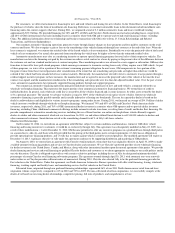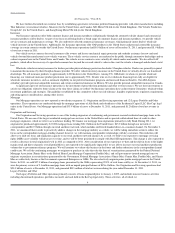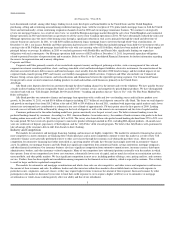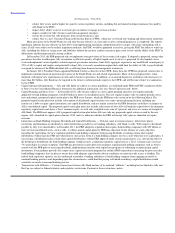Ally Bank 2011 Annual Report Download - page 16
Download and view the complete annual report
Please find page 16 of the 2011 Ally Bank annual report below. You can navigate through the pages in the report by either clicking on the pages listed below, or by using the keyword search tool below to find specific information within the annual report.
Table of Contents
Ally Financial Inc. • Form 10−K
Our ability to execute our business strategy may be affected by regulatory considerations.
Our business strategy for Ally Bank, which is primarily focused on automotive lending and growth of our direct−channel deposit business, is subject
to regulatory oversight from a safety and soundness perspective. If our banking supervisors raise concerns regarding any aspect of our business strategy for
Ally Bank, we may be obliged to alter our strategy, which could include moving certain activities, such as certain types of lending, outside of Ally Bank to
one of our nonbanking affiliates. Alternative funding sources outside of Ally Bank, such as asset securitization or financings in the capital markets, could be
more expensive than funding through Ally Bank and could adversely effect our business prospects, results of operations and financial condition.
We are subject to new capital planning and systemic risk regimes, which impose significant restrictions and requirements.
Effective December 2011, the FRB requires bank holding companies with $50 billion or more in total consolidated assets, such as Ally, to submit
annual capital plans for FRB non−objection. In the absence of a non−objection regarding the capital plan, the new regulation prohibits such bank holding
companies from paying dividends or making certain other capital distributions without a specific FRB non−objection to such action. Even if a bank holding
company receives a non−objection to its capital plan, it may not pay a dividend or make certain other capital distributions without FRB approval under
certain circumstances (e.g., after giving effect to the dividend or distribution, the bank holding company would not meet a minimum regulatory capital ratio
or a Tier 1 common ratio of at least 5%) and subject to certain exceptions. Ally submitted its first capital plan in January 2012, and it is unknown whether
the FRB will accept Ally's plan as submitted or require revisions.
In addition, in December 2011, the FRB proposed rules to implement certain provisions of the systemic risk regime under the Dodd−Frank Wall
Street Reform and Consumer Protection Act (Dodd−Frank Act). If adopted as proposed, among other provisions, the rules would require Ally to maintain a
sufficient quantity of highly liquid assets to survive a projected 30−day liquidity stress event and implement various liquidity−related corporate governance
measures; limit Ally's aggregate exposure to any unaffiliated counterparty to 25% of Ally's capital and surplus; and potentially subject Ally to an early
remediation regime that could limit the ability of Ally to pay dividends or expand its business if the FRB identified Ally as suffering from financial or
management weaknesses. The systemic risk provisions, when implemented, could adversely affect our business prospects, results of operations, and
financial condition.
Our ability to rely on deposits as a part of our funding strategy may be limited.
Ally Bank continues to be a key part of our funding strategy, and we have increased our reliance on deposits as an alternative source of funding
through Ally Bank. Ally Bank does not have a retail branch network, and it obtains its deposits through direct banking and brokered deposits which, at
December 31, 2011, included $9.9 billion of brokered certificates of deposit that may be more price sensitive than other types of deposits and may become
less available if alternative investments offer higher interest rates. Our ability to maintain our current level of deposits or grow our deposit base could be
affected by regulatory restrictions including the possible imposition of prior approval requirements, restrictions on deposit growth, or restrictions on our
rates offered. In addition, perceptions of our financial strength, rates offered by third parties, and other competitive factors beyond our control, including
returns on alternative investments, will also impact our ability to grow our deposit base. As we have established the Ally Bank brand and increased our retail
deposit base over the past few years, we have reduced offered rates on new retail deposits. However, a strategy of continuing to offer reduced rates in the
future could limit our ability to further grow or maintain deposits. Even if we are able to grow the deposit base of Ally Bank, our regulators may impose
restrictions on our ability to use Ally Bank deposits as a source of funding for certain business activities potentially raising the cost of funding those
activities without the use of Ally Bank deposits.
The FDIC has indicated that it expects Ally to diversify Ally Bank's overall funding and to focus on reducing Ally Bank's overall funding costs
including the interest rates paid on Ally Bank deposits. See Management's Discussion and Analysis of Financial Condition and Results of
Operations−Liquidity Management, Funding, and Regulatory Capital−Funding Strategy in Item 7. for additional information about these diversification
activities. As stated above, over the past few years, we have reduced rates on retail deposits, as well as introduced new products, resulting in lower cost of
funds for deposits. However, it is possible that further reductions of rates on retail deposits could limit Ally Bank's ability to grow or maintain deposits,
which could have a material adverse impact on the funding and capital position of Ally.
The regulatory environment in which we operate could have a material adverse effect on our business and earnings.
Our domestic operations are subject to various laws and judicial and administrative decisions imposing various requirements and restrictions relating
to supervision and regulation by state and federal authorities. Such regulation and supervision are primarily for the benefit and protection of our customers,
not for the benefit of investors in our securities, and could limit our discretion in operating our business. Noncompliance with applicable statutes,
regulations, rules, or policies could result in the suspension or revocation of any license or registration at issue as well as the imposition of civil fines and
criminal penalties.
Ally, Ally Bank, and many of our nonbank subsidiaries are heavily regulated by bank and other regulatory agencies at the federal and state levels.
This regulatory oversight is established to protect depositors, the FDIC's Deposit Insurance Fund, and the banking system as a whole, not security holders.
Changes to statutes, regulations, rules, or policies including the interpretation or implementation of statutes, regulations, rules, or policies could affect us in
substantial and unpredictable ways including limiting the types of financial services and products we may offer, limiting our ability to pursue acquisitions
and increasing the ability of third parties to offer competing financial services and products.
13
























